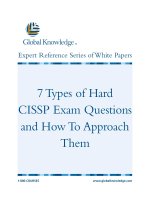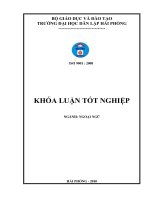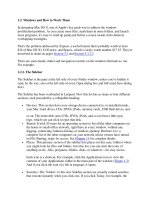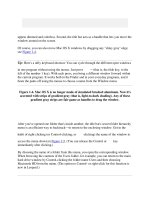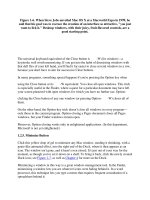Relative clauses in English and Vietnamese, and how to translate them into Vietnamese
Bạn đang xem bản rút gọn của tài liệu. Xem và tải ngay bản đầy đủ của tài liệu tại đây (189.29 KB, 27 trang )
Relative clauses in English and Vietnamese, and
how to translate them into Vietnamese
I. RATIONALE
Learning foreign language is a great significance today. It is the bridge
connecting countries in many fields. The mastery of foreign language enables
us to communicate with people from other countries, achieve mutual
understandings, and further our trade contacts, economic co- operations, and
cultural and academic exchanges with other countries.
I am interested in learning English so much. English, as mentioned over
and over again, is an international language. In Viet Nam, English, now, is the
compulsory subject for pupils in most of primary and secondary school. It is
also an important subject for students at all universities. Particularly English is
one of the essential requirements for those who want to find a good job.
However it is not simple. We have to pay attention not only to grammar,
structure, vocabulary, and pronunciation but also the culture of the new
language. It is easy to make mistakes and often find a lot of difficulties in
translation and when dealing with grammar, especially relative clause. You will
see that, knowing relative clause in English is a matter, understanding and
accurately translating them from English into Vietnamese is another one which
is not as easy as some people might think. In order to help people who are
learning English have deep understanding of relative clauses in English as well
as in Vietnamese, I decide to choose the subject “ Relative clauses in English
and Vietnamese, and how to translate them into Vietnamese” for my graduation
paper.
II. SCOPE OF THE STUDY
Due to the limitation of time and space, in this paper I just focus on main
points of relative clauses and some methods for the translation of relative
clauses from English into Vietnamese in the hope of helping learners of
English have better insight in this part and use it effectively.
III. AIMS OF THE STUDY
I have been learning English for a long time; however, I sometimes make
confusion of using and translating relative clauses in sentence. Like me, many
students also do the same. For the above reason, my study deals with “ Relative
clause in English and Vietnamese, and how to translate them into Vietnamese”
The study is concerned with:
- The definition and classification of relative clause
- The theories that are relevant with relative clause
- The definition of translation and its role
- Common problem in translating relative clause, causes and solutions
- Translating relative clauses into Vietnamese in “ Harry Potter and the
Sorcerer’s Stone”
IV. METHOD OF THE STUDY
To complete this paper I have conducted the following methods:
+ Collecting information from many materials in English and Vietnamese
+ Classifying and analyzing basic data relating to the study
+ Discussing with supervisor and other teachers
V. DESIGN OF THE STUDY
This graduation paper is divided into …chapters:
Chapter I:
Chapter II:
Reference is come to the end.
CHAPTER I: LITERATURE REVIEW
1.1. An overview of relative clause
1.1.1: Definition of relative clause
A relative clause is a subordinate clause which relates or refers to a word
in the clause before it. Some grammarians call it adjective clause or attributive
clause.So among other kinds of clauses, how can you recognize a relative one?
First, it will contain a subject and verb. Next, it will begin with a relative
pronoun (who, whom, whose, that or which) or a relative adverb (when, where
or why). Finally, it will function as an adjective, answering the questions: What
kinds? How many? Or Which one?
In addition, relative clauses can be added to nouns in just about any part
of a sentence--at the beginning, in the middle, and at the end of sentences.
Let's analyze the location and type of relative clause in each of the following
sentences:
1. I bought a book that was highly recommended by my sister.
2. I bought a book that my sister recommended.
3. The book that is required for this workshop comes highly
recommended.
4. The book that my sister recommended was quite useful.
1-I bought a book that was highly recommended by my sister.
Core sentence I bought a book.
Sentence that became the
relative clause
The book was highly recommended by my
sister.
Relative Pronoun Function subject of the relative clause
Location of the relative clause it's at the end of the sentence--attached to the
noun that's the direct object--part of the large
noun phrase that is the direct object
2- I bought a book that my sister recommended.
Core sentence I bought a book.
Sentence that became the relative
clause
My sister recommended the book.
Relative Pronoun Function direct object of the relative clause
Location of the relative clause it's at the end of the sentence--attached to
the noun that's the direct object--part of
the large noun phrase that is the direct
object
3- The book that is required for this workshop comes highly
recommended.
Core sentence The book comes highly recommended.
Sentence that became the
relative clause
The book is required for this workshop.
Relative Pronoun Function subject of the relative clause
Location of the relative clause it's at the beginning of the sentence--attached
to the noun that's the subject--part of the large
noun phrase that is the subject of the sentence
4- The book that my sister recommended was quite useful.
Core sentence The book was quite useful.
Sentence that became the
relative clause
My sister recommended the book.
Relative Pronoun Function direct object of the relative clause
Location of the relative clause it's at the beginning of the sentence--attached to
the noun that's the subject--part of the large
noun phrase that is the subject of the sentence
1.1.2: Classification
There are two types of relative clause
1.1.2.1: Defining relative clause: with other names in different books that
you can encounter: restrictive clause (mệnh đề quan hệ hạn định), essential
clause (mệnh đề quan hệ thiết yếu).
Definition
Defining relative clause gives essential information about the noun or
noun phrase it modifies, the purpose of a defining relative clause is clearly
define who or what we are talking about. Without this information, it would be
difficult to know who or what is meant. Obviously, this is only necessary if
there is more than one person or thing involved.
For example:
The hotel that we stayed in wasn’t bad. (“that we stayed in” tells the
listener which hotel we are talking about; it defines the hotel)
Punctuation
Commas are not used in defining relative clauses.
Relative pronouns
The following relative pronouns are used in defining relative clauses:
Person Thing Place Tim
e
Reason
Subject who/that which/that
Object who/whom/that/ø which/that/ø where when why
Possessiv
e
whose whose
Notes:
1. The relative pronoun stands in place of a noun. This noun usually appears at
the beginning of the sentence:
The book which you lent me was very interesting.
Noun,
subject of
main
clause
relative
pronoun
referring to
“the book”
verb + rest of
relative clause
verb + rest of main clause
2. Who, whom and which can be replaced by that. This is very common in
spoken English.
3. The relative pronoun can be omitted (ø) when it is the object of the clause:
The flowers which/that I cut this morning are still fresh.
OR The flowers I cut this morning are still fresh.
Both of these sentences are correct, though the second one is more common in
spoken English.
The flowers which/that/ø I cut this morning are still fresh.
Noun, subject
of main clause
relative pronoun,
referring to “the
flowers”
verb + rest of relative
clause
verb + rest of main
clause.
(You can usually decide whether a relative pronoun is an object because
it is normally followed by another subject + verb.)
4. Whose is used for things as well as for people.
Examples:
The woman whose child has just been lost is crying.
The house whose windows are broken is mine.
5. Whom is very formal and is only used in written English. You can use
who/that, or omit the pronoun completely :
The doctor whom/who/that/ø I was hoping to see wasn't on duty.
6. That normally follows:
+ words like : all, any, only, the first, the last, and sometimes follows: It is/It
was.
- I have said all that I want to say.
- Any paper (that) you read will give you the same story.
- He is the only boy that can answer all the questions in the test.
- It is his wife that makes the decisions in his family.
- It was the first time that John heard of it.
+ superlatives
- He was the best man that I have ever seen.
- He is the most courageous man that ever lived.
+ indefinite pronouns: noone, nobody, nothing, someone, somebody,
anything,…
- She always had everything that she wanted.
- He never says anything that is worth listening to.
- It was not for nothing that he studied carpentry.
1.1.2.2: Non- defining relative clause ( mệnh đề quan hệ không hạn định hay
mệnh đề quan hệ bổ túc)
Other materials can refer this kind of clause as non- restrictive clause or:
+) Parenthetical clause (mệnh đề quan hệ chêm)
+) Amplifying clause (mệnh đề quan hệ giải thích)
+) Non- essential clause ( mệnh đề quan hệ không thiết yếu)
Definition
Non- defining relative clause provides interesting additional information
which is not essential to understanding the meaning of the sentence. It tells us
more about someone or something, but do not define it.
For example:
My sister, who lives in France, is coming to stay with me next week.
Punctuation
Correct punctuation is essential in non-defining relative clauses. If the non-
defining relative clause occurs in the middle of a sentence, a comma is put
before the relative pronoun and at the end of the clause. If the non-defining
relative clause occurs at the end of a sentence, a comma is put before the
relative pronoun.
For example
• My friend John, who went to the same school as me, has just written a
best-selling novel.
Relative pronouns in non-defining clauses
Person Thing Place
Subject who which
Object who/whom which where
Possessive whose
Notes:
1. In non-defining clauses, you cannot use ‘that’ instead of who, whom or
which.
2. You cannot leave out the relative pronoun, even when it is the object of the
verb in the relative clause:
- He gave me the letter, which was in a blue envelope.
- He gave me the letter, which I read immediately
3. The preposition in these clauses can go at the end of the clause, e.g.
- This is Stratford-on-Avon, which you have all heard about.
This pattern is often used in spoken English, but in written or formal English
you can also put the preposition before the pronoun:
Eg: Stratford-on-Avon, about which many people have written is Shakespeare’s
birthplace.
4. Non-defining clauses can be introduced by expressions like all of, many of +
relative pronoun:
Person Thing
all of + whom + which
any of + whom + which
(a) few of + whom + which
both of + whom + which
each of + whom + which
either of + whom + which
half of + whom + which
many of + whom + which
most of + whom + which
much of + whom + which
none of + whom + which
one of + whom + which
two of etc… + whom + which
Examples:
a. There were a lot of people at the party, many of whom I had known
for years.
b. He was carrying his belongings, many of which were broken.
5. The relative pronoun which at the beginning of a non-defining relative
clause, can refer to all the information contained in the previous part of the
sentence, rather than to just one word.
a. Chris did really well in his exams, which was a big surprise. (= the fact
that he did well in his exams was a big surprise).
b. An elephant and a mouse fell in love, which is most unusual. (= the
fact that they fell in love is unusual).
1.1.3: Some notes on relative clause and other cases
1.1.3.1: Commas in relative clause



